Indigenous Music's Role in Chewa Life & Culture, South Africa
VerifiedAdded on 2022/11/13
|8
|2110
|475
Essay
AI Summary
This essay examines the vital role of indigenous African music in the life and culture of the Chewa people of South Africa. It begins by introducing the Chewa people, their history, and their cultural practices. The essay then delves into the significance of indigenous music, highlighting its use in ceremonies, storytelling, social bonding, and communication. It further explores specific musical instruments like the ramkie, mamokhorong, chipendani, and penny whistle, and discusses how these instruments are used in various cultural contexts. The essay concludes by emphasizing the importance of preserving and promoting indigenous music as a means of celebrating cultural heritage, fostering unity, and facilitating communication within the Chewa community. The paper also highlights how music was used to criticize the apartheid regime and promote harmony in the community. Desklib offers similar resources for students.
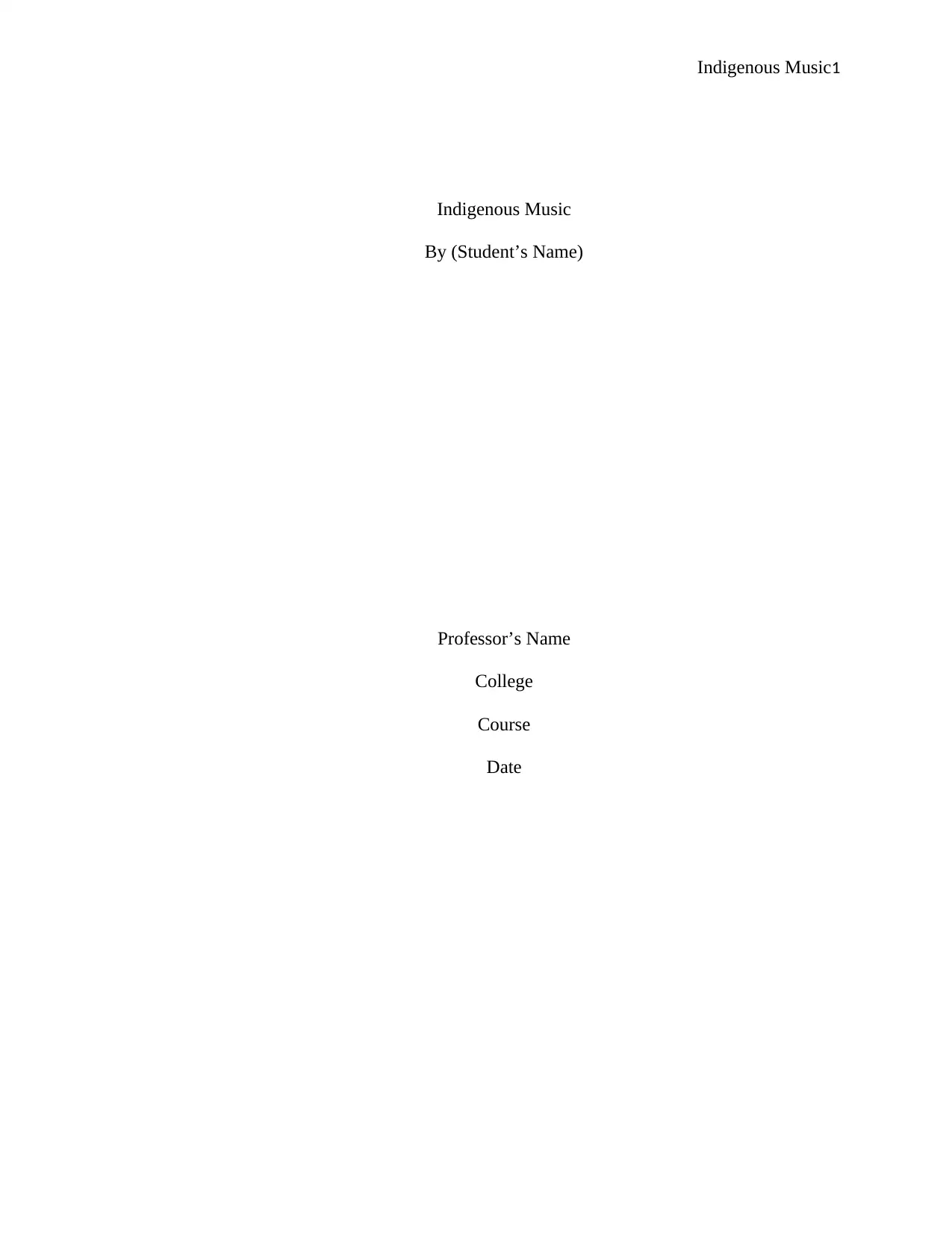
Indigenous Music1
Indigenous Music
By (Student’s Name)
Professor’s Name
College
Course
Date
Indigenous Music
By (Student’s Name)
Professor’s Name
College
Course
Date
Paraphrase This Document
Need a fresh take? Get an instant paraphrase of this document with our AI Paraphraser
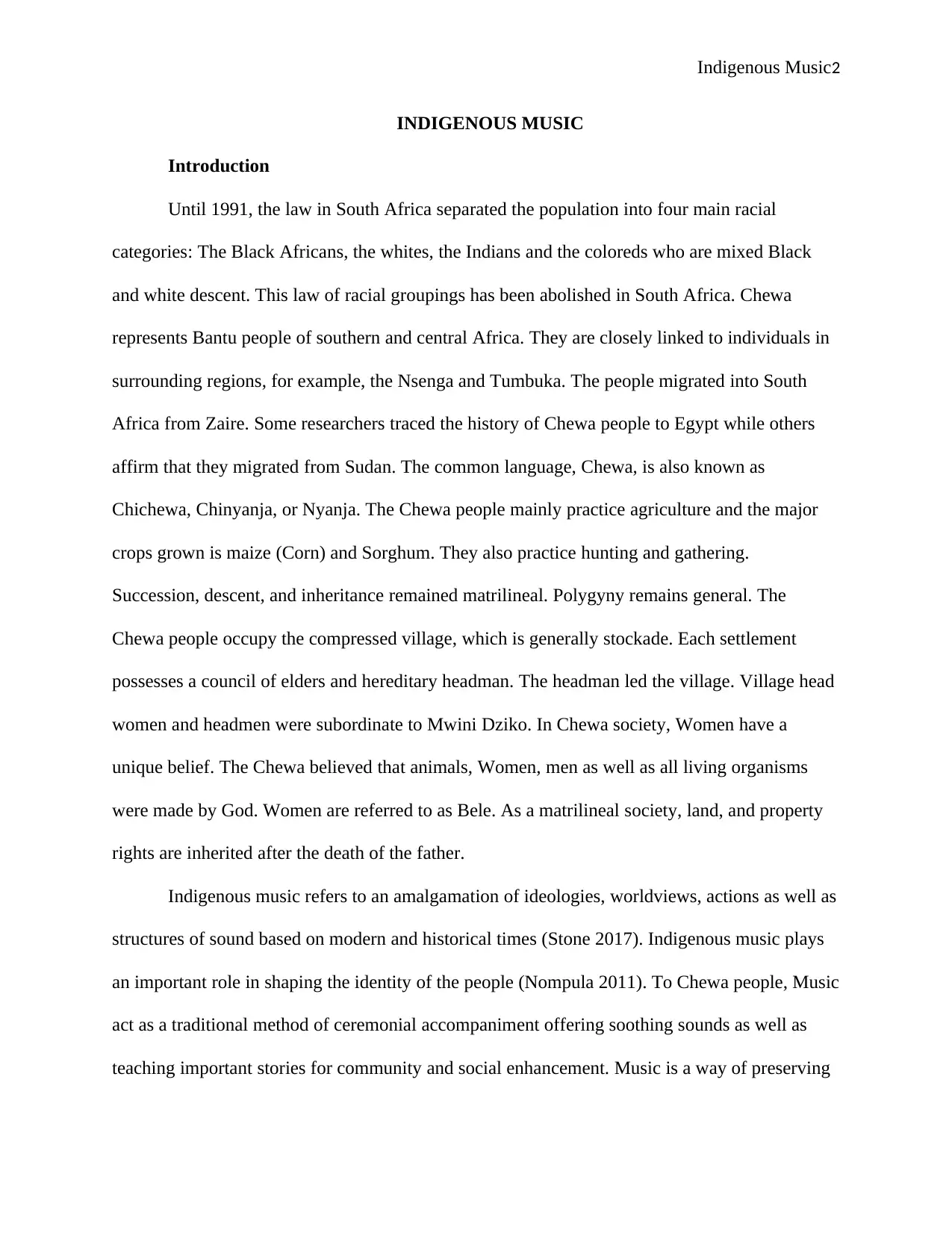
Indigenous Music2
INDIGENOUS MUSIC
Introduction
Until 1991, the law in South Africa separated the population into four main racial
categories: The Black Africans, the whites, the Indians and the coloreds who are mixed Black
and white descent. This law of racial groupings has been abolished in South Africa. Chewa
represents Bantu people of southern and central Africa. They are closely linked to individuals in
surrounding regions, for example, the Nsenga and Tumbuka. The people migrated into South
Africa from Zaire. Some researchers traced the history of Chewa people to Egypt while others
affirm that they migrated from Sudan. The common language, Chewa, is also known as
Chichewa, Chinyanja, or Nyanja. The Chewa people mainly practice agriculture and the major
crops grown is maize (Corn) and Sorghum. They also practice hunting and gathering.
Succession, descent, and inheritance remained matrilineal. Polygyny remains general. The
Chewa people occupy the compressed village, which is generally stockade. Each settlement
possesses a council of elders and hereditary headman. The headman led the village. Village head
women and headmen were subordinate to Mwini Dziko. In Chewa society, Women have a
unique belief. The Chewa believed that animals, Women, men as well as all living organisms
were made by God. Women are referred to as Bele. As a matrilineal society, land, and property
rights are inherited after the death of the father.
Indigenous music refers to an amalgamation of ideologies, worldviews, actions as well as
structures of sound based on modern and historical times (Stone 2017). Indigenous music plays
an important role in shaping the identity of the people (Nompula 2011). To Chewa people, Music
act as a traditional method of ceremonial accompaniment offering soothing sounds as well as
teaching important stories for community and social enhancement. Music is a way of preserving
INDIGENOUS MUSIC
Introduction
Until 1991, the law in South Africa separated the population into four main racial
categories: The Black Africans, the whites, the Indians and the coloreds who are mixed Black
and white descent. This law of racial groupings has been abolished in South Africa. Chewa
represents Bantu people of southern and central Africa. They are closely linked to individuals in
surrounding regions, for example, the Nsenga and Tumbuka. The people migrated into South
Africa from Zaire. Some researchers traced the history of Chewa people to Egypt while others
affirm that they migrated from Sudan. The common language, Chewa, is also known as
Chichewa, Chinyanja, or Nyanja. The Chewa people mainly practice agriculture and the major
crops grown is maize (Corn) and Sorghum. They also practice hunting and gathering.
Succession, descent, and inheritance remained matrilineal. Polygyny remains general. The
Chewa people occupy the compressed village, which is generally stockade. Each settlement
possesses a council of elders and hereditary headman. The headman led the village. Village head
women and headmen were subordinate to Mwini Dziko. In Chewa society, Women have a
unique belief. The Chewa believed that animals, Women, men as well as all living organisms
were made by God. Women are referred to as Bele. As a matrilineal society, land, and property
rights are inherited after the death of the father.
Indigenous music refers to an amalgamation of ideologies, worldviews, actions as well as
structures of sound based on modern and historical times (Stone 2017). Indigenous music plays
an important role in shaping the identity of the people (Nompula 2011). To Chewa people, Music
act as a traditional method of ceremonial accompaniment offering soothing sounds as well as
teaching important stories for community and social enhancement. Music is a way of preserving
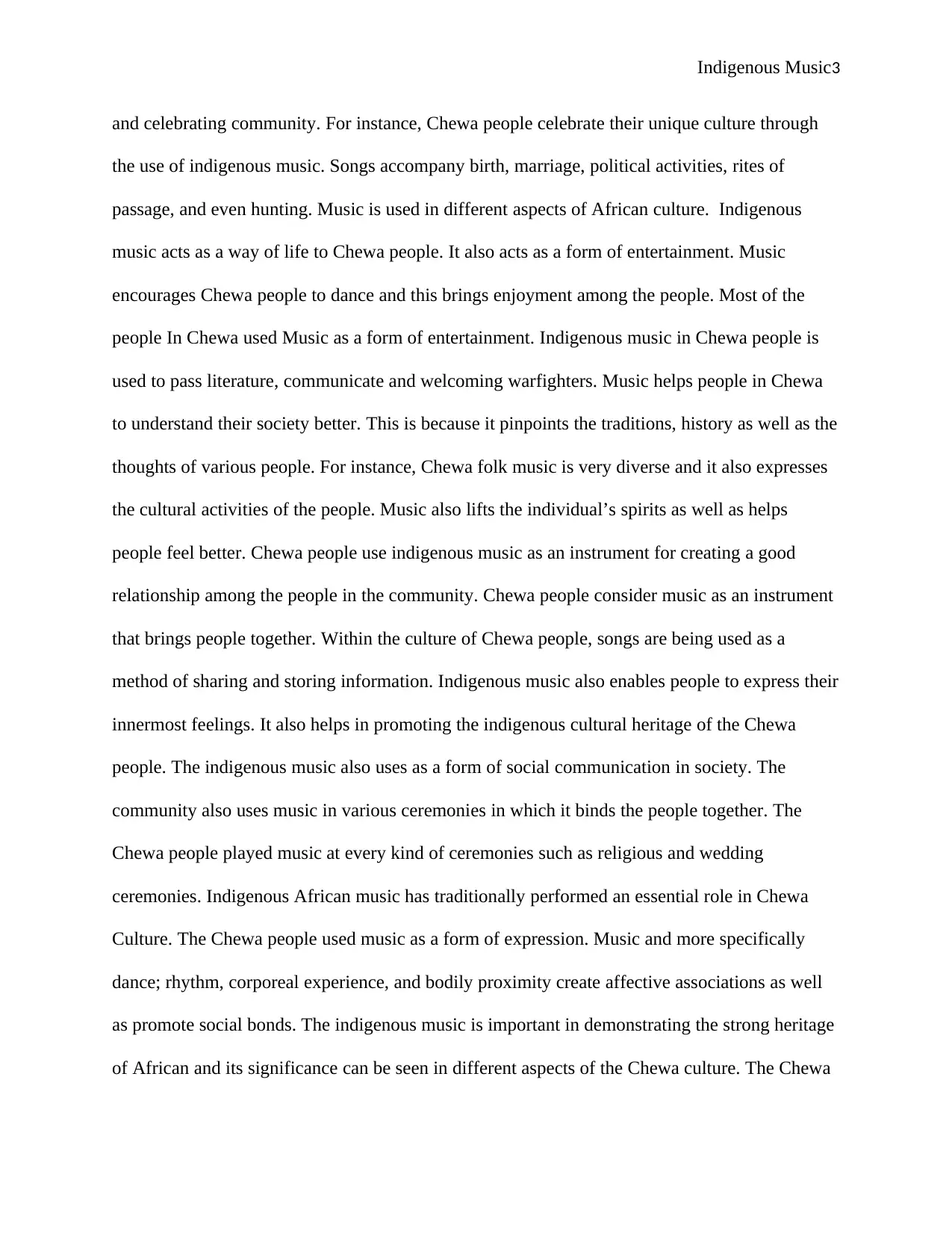
Indigenous Music3
and celebrating community. For instance, Chewa people celebrate their unique culture through
the use of indigenous music. Songs accompany birth, marriage, political activities, rites of
passage, and even hunting. Music is used in different aspects of African culture. Indigenous
music acts as a way of life to Chewa people. It also acts as a form of entertainment. Music
encourages Chewa people to dance and this brings enjoyment among the people. Most of the
people In Chewa used Music as a form of entertainment. Indigenous music in Chewa people is
used to pass literature, communicate and welcoming warfighters. Music helps people in Chewa
to understand their society better. This is because it pinpoints the traditions, history as well as the
thoughts of various people. For instance, Chewa folk music is very diverse and it also expresses
the cultural activities of the people. Music also lifts the individual’s spirits as well as helps
people feel better. Chewa people use indigenous music as an instrument for creating a good
relationship among the people in the community. Chewa people consider music as an instrument
that brings people together. Within the culture of Chewa people, songs are being used as a
method of sharing and storing information. Indigenous music also enables people to express their
innermost feelings. It also helps in promoting the indigenous cultural heritage of the Chewa
people. The indigenous music also uses as a form of social communication in society. The
community also uses music in various ceremonies in which it binds the people together. The
Chewa people played music at every kind of ceremonies such as religious and wedding
ceremonies. Indigenous African music has traditionally performed an essential role in Chewa
Culture. The Chewa people used music as a form of expression. Music and more specifically
dance; rhythm, corporeal experience, and bodily proximity create affective associations as well
as promote social bonds. The indigenous music is important in demonstrating the strong heritage
of African and its significance can be seen in different aspects of the Chewa culture. The Chewa
and celebrating community. For instance, Chewa people celebrate their unique culture through
the use of indigenous music. Songs accompany birth, marriage, political activities, rites of
passage, and even hunting. Music is used in different aspects of African culture. Indigenous
music acts as a way of life to Chewa people. It also acts as a form of entertainment. Music
encourages Chewa people to dance and this brings enjoyment among the people. Most of the
people In Chewa used Music as a form of entertainment. Indigenous music in Chewa people is
used to pass literature, communicate and welcoming warfighters. Music helps people in Chewa
to understand their society better. This is because it pinpoints the traditions, history as well as the
thoughts of various people. For instance, Chewa folk music is very diverse and it also expresses
the cultural activities of the people. Music also lifts the individual’s spirits as well as helps
people feel better. Chewa people use indigenous music as an instrument for creating a good
relationship among the people in the community. Chewa people consider music as an instrument
that brings people together. Within the culture of Chewa people, songs are being used as a
method of sharing and storing information. Indigenous music also enables people to express their
innermost feelings. It also helps in promoting the indigenous cultural heritage of the Chewa
people. The indigenous music also uses as a form of social communication in society. The
community also uses music in various ceremonies in which it binds the people together. The
Chewa people played music at every kind of ceremonies such as religious and wedding
ceremonies. Indigenous African music has traditionally performed an essential role in Chewa
Culture. The Chewa people used music as a form of expression. Music and more specifically
dance; rhythm, corporeal experience, and bodily proximity create affective associations as well
as promote social bonds. The indigenous music is important in demonstrating the strong heritage
of African and its significance can be seen in different aspects of the Chewa culture. The Chewa
⊘ This is a preview!⊘
Do you want full access?
Subscribe today to unlock all pages.

Trusted by 1+ million students worldwide
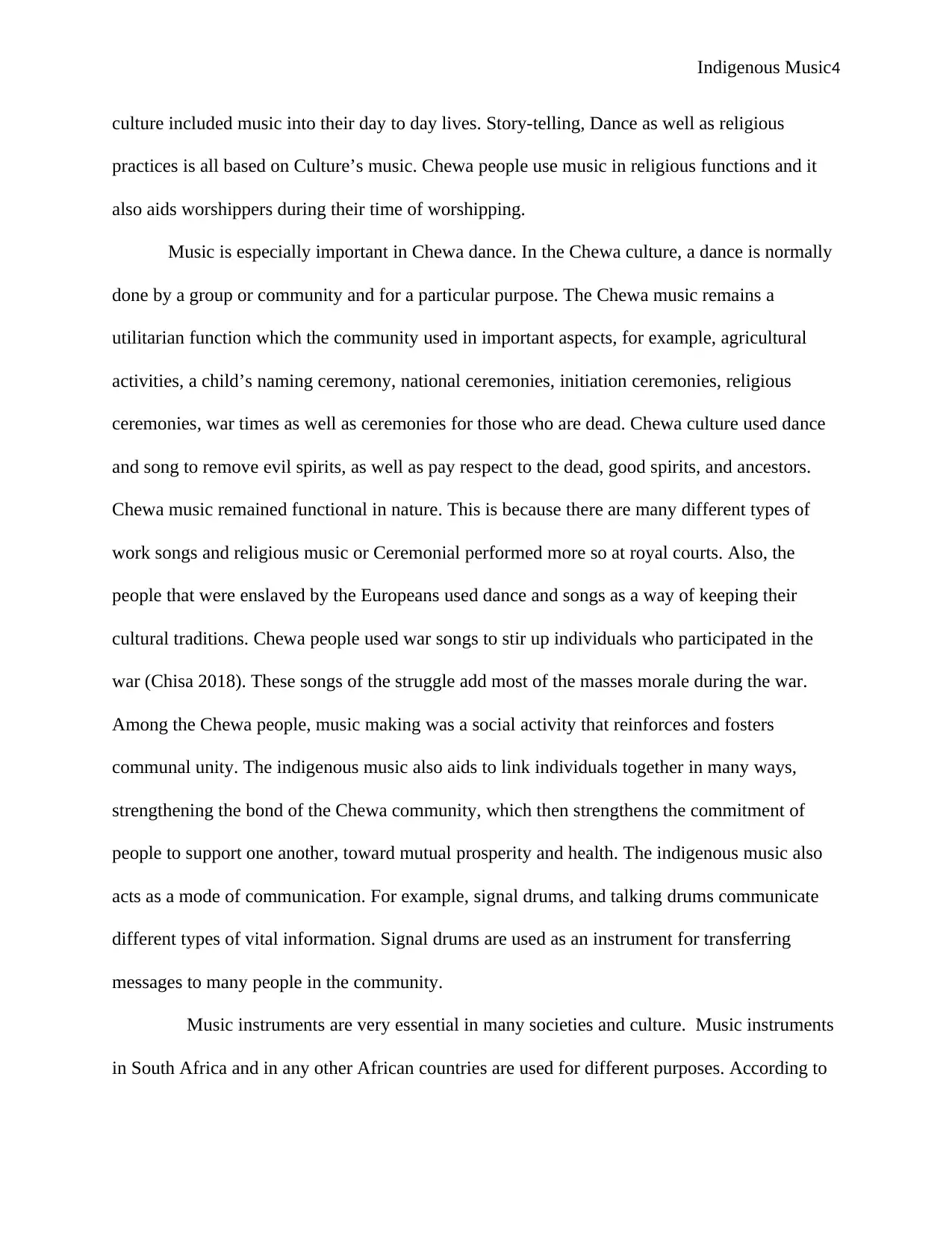
Indigenous Music4
culture included music into their day to day lives. Story-telling, Dance as well as religious
practices is all based on Culture’s music. Chewa people use music in religious functions and it
also aids worshippers during their time of worshipping.
Music is especially important in Chewa dance. In the Chewa culture, a dance is normally
done by a group or community and for a particular purpose. The Chewa music remains a
utilitarian function which the community used in important aspects, for example, agricultural
activities, a child’s naming ceremony, national ceremonies, initiation ceremonies, religious
ceremonies, war times as well as ceremonies for those who are dead. Chewa culture used dance
and song to remove evil spirits, as well as pay respect to the dead, good spirits, and ancestors.
Chewa music remained functional in nature. This is because there are many different types of
work songs and religious music or Ceremonial performed more so at royal courts. Also, the
people that were enslaved by the Europeans used dance and songs as a way of keeping their
cultural traditions. Chewa people used war songs to stir up individuals who participated in the
war (Chisa 2018). These songs of the struggle add most of the masses morale during the war.
Among the Chewa people, music making was a social activity that reinforces and fosters
communal unity. The indigenous music also aids to link individuals together in many ways,
strengthening the bond of the Chewa community, which then strengthens the commitment of
people to support one another, toward mutual prosperity and health. The indigenous music also
acts as a mode of communication. For example, signal drums, and talking drums communicate
different types of vital information. Signal drums are used as an instrument for transferring
messages to many people in the community.
Music instruments are very essential in many societies and culture. Music instruments
in South Africa and in any other African countries are used for different purposes. According to
culture included music into their day to day lives. Story-telling, Dance as well as religious
practices is all based on Culture’s music. Chewa people use music in religious functions and it
also aids worshippers during their time of worshipping.
Music is especially important in Chewa dance. In the Chewa culture, a dance is normally
done by a group or community and for a particular purpose. The Chewa music remains a
utilitarian function which the community used in important aspects, for example, agricultural
activities, a child’s naming ceremony, national ceremonies, initiation ceremonies, religious
ceremonies, war times as well as ceremonies for those who are dead. Chewa culture used dance
and song to remove evil spirits, as well as pay respect to the dead, good spirits, and ancestors.
Chewa music remained functional in nature. This is because there are many different types of
work songs and religious music or Ceremonial performed more so at royal courts. Also, the
people that were enslaved by the Europeans used dance and songs as a way of keeping their
cultural traditions. Chewa people used war songs to stir up individuals who participated in the
war (Chisa 2018). These songs of the struggle add most of the masses morale during the war.
Among the Chewa people, music making was a social activity that reinforces and fosters
communal unity. The indigenous music also aids to link individuals together in many ways,
strengthening the bond of the Chewa community, which then strengthens the commitment of
people to support one another, toward mutual prosperity and health. The indigenous music also
acts as a mode of communication. For example, signal drums, and talking drums communicate
different types of vital information. Signal drums are used as an instrument for transferring
messages to many people in the community.
Music instruments are very essential in many societies and culture. Music instruments
in South Africa and in any other African countries are used for different purposes. According to
Paraphrase This Document
Need a fresh take? Get an instant paraphrase of this document with our AI Paraphraser
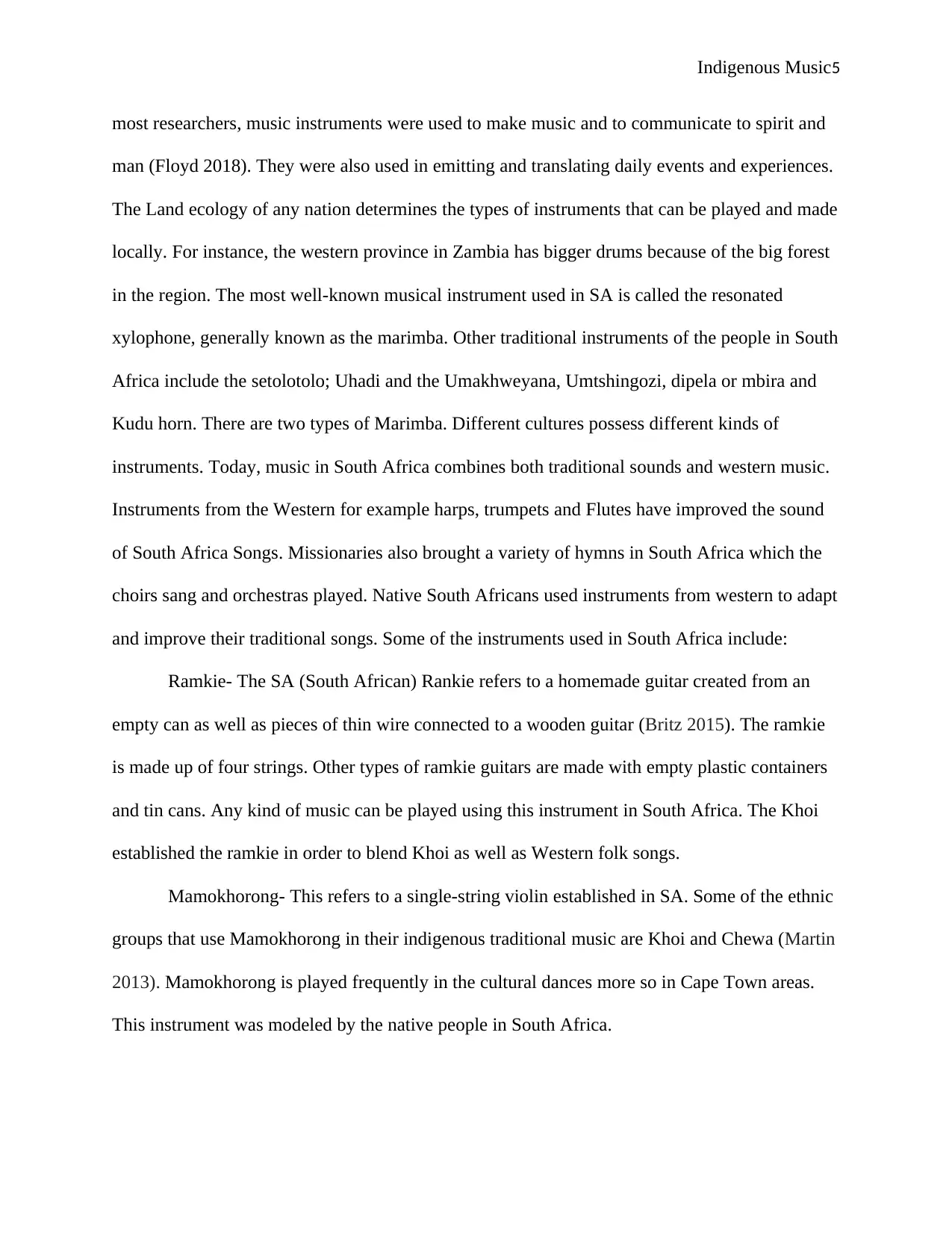
Indigenous Music5
most researchers, music instruments were used to make music and to communicate to spirit and
man (Floyd 2018). They were also used in emitting and translating daily events and experiences.
The Land ecology of any nation determines the types of instruments that can be played and made
locally. For instance, the western province in Zambia has bigger drums because of the big forest
in the region. The most well-known musical instrument used in SA is called the resonated
xylophone, generally known as the marimba. Other traditional instruments of the people in South
Africa include the setolotolo; Uhadi and the Umakhweyana, Umtshingozi, dipela or mbira and
Kudu horn. There are two types of Marimba. Different cultures possess different kinds of
instruments. Today, music in South Africa combines both traditional sounds and western music.
Instruments from the Western for example harps, trumpets and Flutes have improved the sound
of South Africa Songs. Missionaries also brought a variety of hymns in South Africa which the
choirs sang and orchestras played. Native South Africans used instruments from western to adapt
and improve their traditional songs. Some of the instruments used in South Africa include:
Ramkie- The SA (South African) Rankie refers to a homemade guitar created from an
empty can as well as pieces of thin wire connected to a wooden guitar (Britz 2015). The ramkie
is made up of four strings. Other types of ramkie guitars are made with empty plastic containers
and tin cans. Any kind of music can be played using this instrument in South Africa. The Khoi
established the ramkie in order to blend Khoi as well as Western folk songs.
Mamokhorong- This refers to a single-string violin established in SA. Some of the ethnic
groups that use Mamokhorong in their indigenous traditional music are Khoi and Chewa (Martin
2013). Mamokhorong is played frequently in the cultural dances more so in Cape Town areas.
This instrument was modeled by the native people in South Africa.
most researchers, music instruments were used to make music and to communicate to spirit and
man (Floyd 2018). They were also used in emitting and translating daily events and experiences.
The Land ecology of any nation determines the types of instruments that can be played and made
locally. For instance, the western province in Zambia has bigger drums because of the big forest
in the region. The most well-known musical instrument used in SA is called the resonated
xylophone, generally known as the marimba. Other traditional instruments of the people in South
Africa include the setolotolo; Uhadi and the Umakhweyana, Umtshingozi, dipela or mbira and
Kudu horn. There are two types of Marimba. Different cultures possess different kinds of
instruments. Today, music in South Africa combines both traditional sounds and western music.
Instruments from the Western for example harps, trumpets and Flutes have improved the sound
of South Africa Songs. Missionaries also brought a variety of hymns in South Africa which the
choirs sang and orchestras played. Native South Africans used instruments from western to adapt
and improve their traditional songs. Some of the instruments used in South Africa include:
Ramkie- The SA (South African) Rankie refers to a homemade guitar created from an
empty can as well as pieces of thin wire connected to a wooden guitar (Britz 2015). The ramkie
is made up of four strings. Other types of ramkie guitars are made with empty plastic containers
and tin cans. Any kind of music can be played using this instrument in South Africa. The Khoi
established the ramkie in order to blend Khoi as well as Western folk songs.
Mamokhorong- This refers to a single-string violin established in SA. Some of the ethnic
groups that use Mamokhorong in their indigenous traditional music are Khoi and Chewa (Martin
2013). Mamokhorong is played frequently in the cultural dances more so in Cape Town areas.
This instrument was modeled by the native people in South Africa.
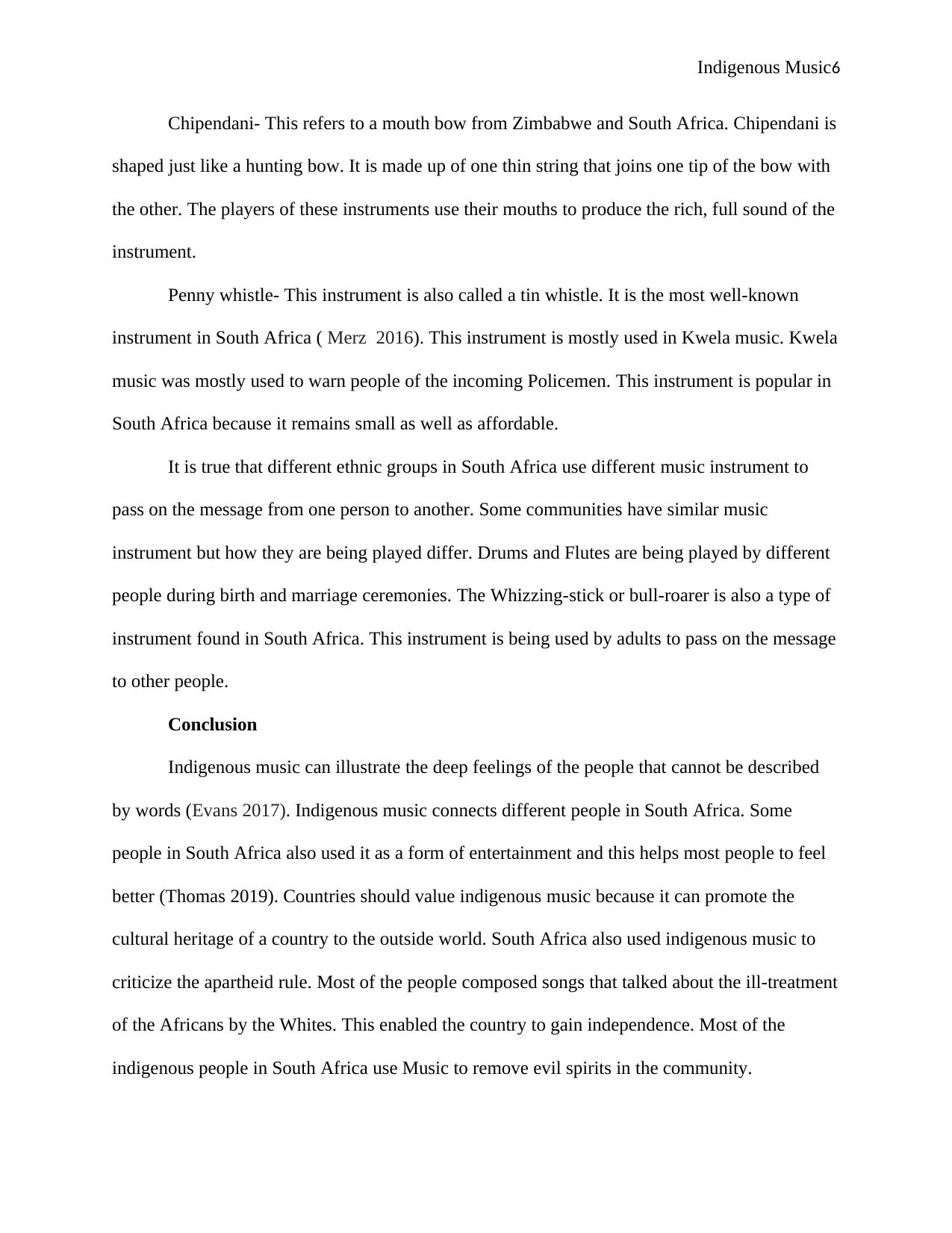
Indigenous Music6
Chipendani- This refers to a mouth bow from Zimbabwe and South Africa. Chipendani is
shaped just like a hunting bow. It is made up of one thin string that joins one tip of the bow with
the other. The players of these instruments use their mouths to produce the rich, full sound of the
instrument.
Penny whistle- This instrument is also called a tin whistle. It is the most well-known
instrument in South Africa ( Merz 2016). This instrument is mostly used in Kwela music. Kwela
music was mostly used to warn people of the incoming Policemen. This instrument is popular in
South Africa because it remains small as well as affordable.
It is true that different ethnic groups in South Africa use different music instrument to
pass on the message from one person to another. Some communities have similar music
instrument but how they are being played differ. Drums and Flutes are being played by different
people during birth and marriage ceremonies. The Whizzing-stick or bull-roarer is also a type of
instrument found in South Africa. This instrument is being used by adults to pass on the message
to other people.
Conclusion
Indigenous music can illustrate the deep feelings of the people that cannot be described
by words (Evans 2017). Indigenous music connects different people in South Africa. Some
people in South Africa also used it as a form of entertainment and this helps most people to feel
better (Thomas 2019). Countries should value indigenous music because it can promote the
cultural heritage of a country to the outside world. South Africa also used indigenous music to
criticize the apartheid rule. Most of the people composed songs that talked about the ill-treatment
of the Africans by the Whites. This enabled the country to gain independence. Most of the
indigenous people in South Africa use Music to remove evil spirits in the community.
Chipendani- This refers to a mouth bow from Zimbabwe and South Africa. Chipendani is
shaped just like a hunting bow. It is made up of one thin string that joins one tip of the bow with
the other. The players of these instruments use their mouths to produce the rich, full sound of the
instrument.
Penny whistle- This instrument is also called a tin whistle. It is the most well-known
instrument in South Africa ( Merz 2016). This instrument is mostly used in Kwela music. Kwela
music was mostly used to warn people of the incoming Policemen. This instrument is popular in
South Africa because it remains small as well as affordable.
It is true that different ethnic groups in South Africa use different music instrument to
pass on the message from one person to another. Some communities have similar music
instrument but how they are being played differ. Drums and Flutes are being played by different
people during birth and marriage ceremonies. The Whizzing-stick or bull-roarer is also a type of
instrument found in South Africa. This instrument is being used by adults to pass on the message
to other people.
Conclusion
Indigenous music can illustrate the deep feelings of the people that cannot be described
by words (Evans 2017). Indigenous music connects different people in South Africa. Some
people in South Africa also used it as a form of entertainment and this helps most people to feel
better (Thomas 2019). Countries should value indigenous music because it can promote the
cultural heritage of a country to the outside world. South Africa also used indigenous music to
criticize the apartheid rule. Most of the people composed songs that talked about the ill-treatment
of the Africans by the Whites. This enabled the country to gain independence. Most of the
indigenous people in South Africa use Music to remove evil spirits in the community.
⊘ This is a preview!⊘
Do you want full access?
Subscribe today to unlock all pages.

Trusted by 1+ million students worldwide
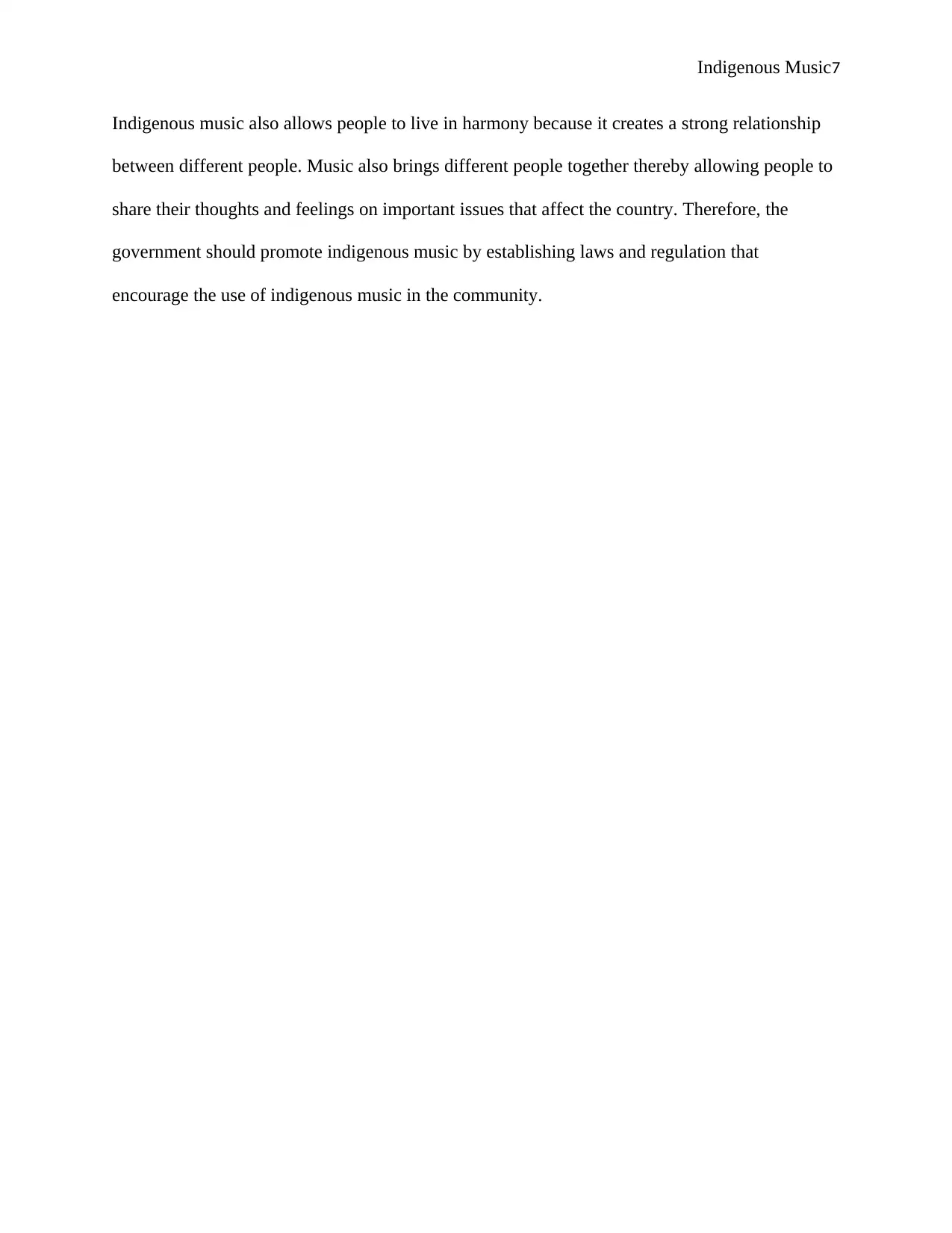
Indigenous Music7
Indigenous music also allows people to live in harmony because it creates a strong relationship
between different people. Music also brings different people together thereby allowing people to
share their thoughts and feelings on important issues that affect the country. Therefore, the
government should promote indigenous music by establishing laws and regulation that
encourage the use of indigenous music in the community.
Indigenous music also allows people to live in harmony because it creates a strong relationship
between different people. Music also brings different people together thereby allowing people to
share their thoughts and feelings on important issues that affect the country. Therefore, the
government should promote indigenous music by establishing laws and regulation that
encourage the use of indigenous music in the community.
Paraphrase This Document
Need a fresh take? Get an instant paraphrase of this document with our AI Paraphraser
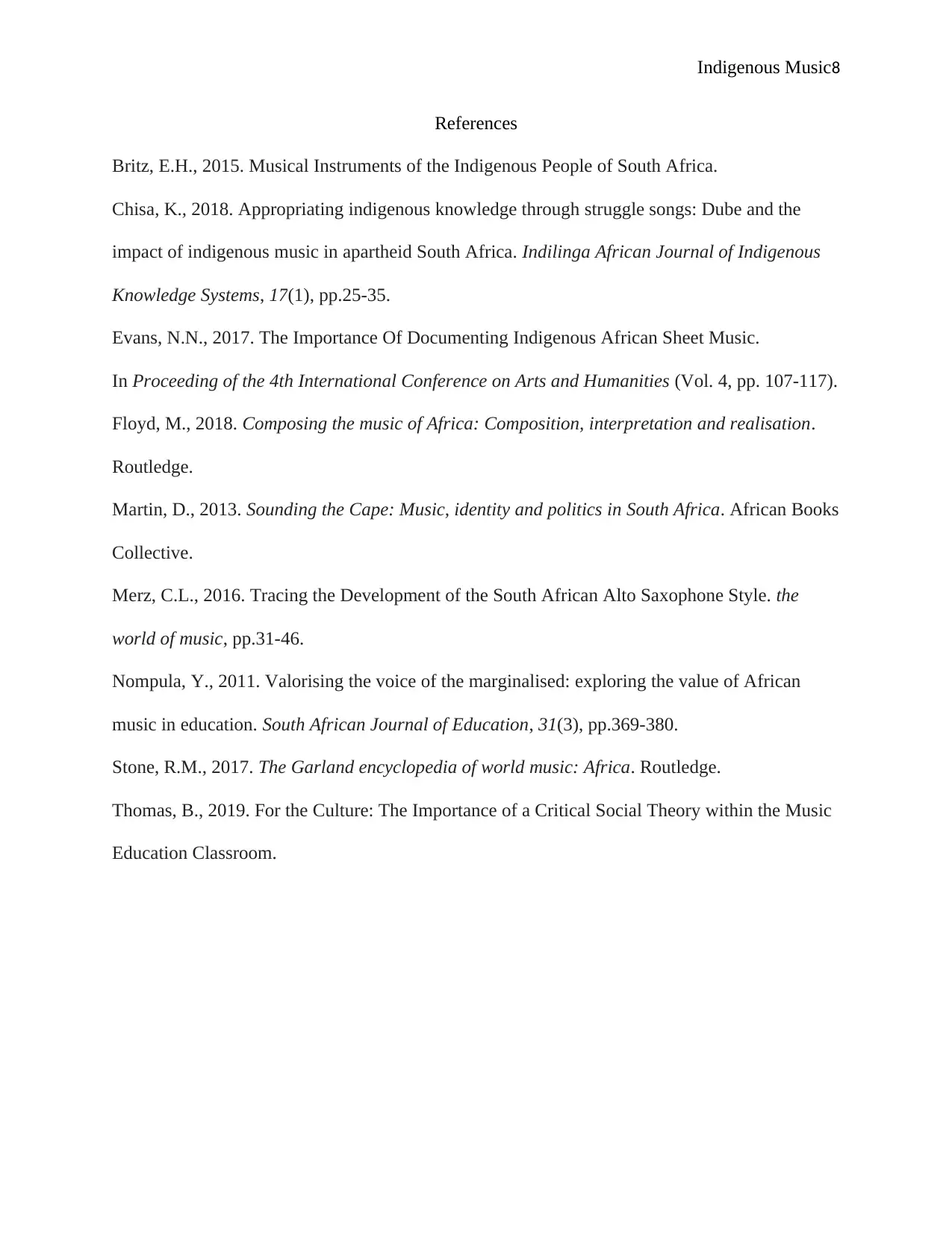
Indigenous Music8
References
Britz, E.H., 2015. Musical Instruments of the Indigenous People of South Africa.
Chisa, K., 2018. Appropriating indigenous knowledge through struggle songs: Dube and the
impact of indigenous music in apartheid South Africa. Indilinga African Journal of Indigenous
Knowledge Systems, 17(1), pp.25-35.
Evans, N.N., 2017. The Importance Of Documenting Indigenous African Sheet Music.
In Proceeding of the 4th International Conference on Arts and Humanities (Vol. 4, pp. 107-117).
Floyd, M., 2018. Composing the music of Africa: Composition, interpretation and realisation.
Routledge.
Martin, D., 2013. Sounding the Cape: Music, identity and politics in South Africa. African Books
Collective.
Merz, C.L., 2016. Tracing the Development of the South African Alto Saxophone Style. the
world of music, pp.31-46.
Nompula, Y., 2011. Valorising the voice of the marginalised: exploring the value of African
music in education. South African Journal of Education, 31(3), pp.369-380.
Stone, R.M., 2017. The Garland encyclopedia of world music: Africa. Routledge.
Thomas, B., 2019. For the Culture: The Importance of a Critical Social Theory within the Music
Education Classroom.
References
Britz, E.H., 2015. Musical Instruments of the Indigenous People of South Africa.
Chisa, K., 2018. Appropriating indigenous knowledge through struggle songs: Dube and the
impact of indigenous music in apartheid South Africa. Indilinga African Journal of Indigenous
Knowledge Systems, 17(1), pp.25-35.
Evans, N.N., 2017. The Importance Of Documenting Indigenous African Sheet Music.
In Proceeding of the 4th International Conference on Arts and Humanities (Vol. 4, pp. 107-117).
Floyd, M., 2018. Composing the music of Africa: Composition, interpretation and realisation.
Routledge.
Martin, D., 2013. Sounding the Cape: Music, identity and politics in South Africa. African Books
Collective.
Merz, C.L., 2016. Tracing the Development of the South African Alto Saxophone Style. the
world of music, pp.31-46.
Nompula, Y., 2011. Valorising the voice of the marginalised: exploring the value of African
music in education. South African Journal of Education, 31(3), pp.369-380.
Stone, R.M., 2017. The Garland encyclopedia of world music: Africa. Routledge.
Thomas, B., 2019. For the Culture: The Importance of a Critical Social Theory within the Music
Education Classroom.
1 out of 8
Your All-in-One AI-Powered Toolkit for Academic Success.
+13062052269
info@desklib.com
Available 24*7 on WhatsApp / Email
![[object Object]](/_next/static/media/star-bottom.7253800d.svg)
Unlock your academic potential
Copyright © 2020–2025 A2Z Services. All Rights Reserved. Developed and managed by ZUCOL.